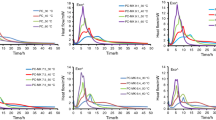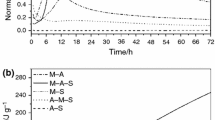Abstract
The calcined gypsum–lime–metakaolin–water system and its subsystems consisting of two and three components are analyzed using the isothermal heat flow calorimetry, differential scanning calorimetry, and thermogravimetry. The hydration heat development in the initial hydration phase up to several hours is monitored in a common way, on the samples having a mass of about 1 g. In later time intervals up to 1 week when the values of the specific hydration heat power are very low, a large-volume calorimeter with better resolution is used for 300 g samples. The thermal analysis is carried out with the specimens undergoing hydration for the time periods of one to 8 days. The isothermal heat flow calorimetry shows that in the analyzed system and its subsystems, the majority of hydration heat is evolved during ~1.5 h after beginning of the hydration process. After 25 h, measurable amounts of hydration heat are produced in the gypsum–lime–metakaolin and metakaolin–lime mixes only, indicating a pozzolanic reaction in progress. In both these mixes, the differential scanning calorimetry reveals seven endothermic peaks corresponding to the thermal decomposition processes occurring during the heating up to 1000 °C. After 8 days of hydration, all Ca(OH)2 is found missing in the gypsum–lime–metakaolin and metakaolin–lime mixtures, which points to the completion of the pozzolanic reaction. The results obtained by the differential scanning calorimetry are well correlated with the mass changes measured by thermogravimetry and derivative thermogravimetry.








Similar content being viewed by others
References
Tydlitát V, Medveď I, Černý R. Determination of partial phase composition in calcined gypsum by calorimetric analysis of hydration kinetics. J Therm Anal Calorim. 2012;109:57–62.
Vimmrová A, Keppert M, Michalko O, Černý R. Calcined gypsum–lime–metakaolin binders: design of optimal composition. Cement Concrete Compos. 2014;52:91–6.
Carlson ET. Hydrogarnet formation in the system lime–alumina–silica–water. J Res Nat Bur Stand. 1956;56:327–35.
McZura G, Hart LD, Heilich RP, Kopanda JE. Refractory cements. In: Proceedings of the raw materials for refractories conference, Feb. 8–9, 1982. The University of Alabama, Alabama, 1982, p. 46–67.
Serry MA, Taha MS, El-Hemaly SAS, El-Didamony H. Metakaolin-lime hydration products. Thermochim Acta. 1984;79:103–10.
Ropp RC. Encyclopedia of the alkaline earth compounds. London: Elsevier; 2013.
Murat M. Hydration reaction and hardening of calcined clays and related minerals. I. Preliminary investigations of metakaolinite. Cement Concrete Res. 1983;13:259–66.
Hewlett P. Lea´s chemistry of cement. 4th ed. Butterworth: Heinemann; 2004.
Cabrera J, Rojas MF. Mechanism of hydration of the metakaolin–lime–water system. Cement Concrete Res. 2001;31:177–82.
Rojas MF, Cabrera J. The effect of temperature on the hydration rate and stability of the hydration phases of metakaolin–lime–water systems. Cement Concrete Res. 2002;32:133–8.
Dojkov I, Stojanov S, Ninov J, Petrov B. On the consumption of lime by metakaolin, fly ash and kaoline in model systems. J. Chem. Technol. Metall. 2013;48:54–60.
Ninov J, Doykov I, Dimova L, Petrov B, Brakalov L. On the kinetics of pozzolanic reaction in metakaolin–lime–water system. J Therm Anal Calorim. 2011;105:245–50.
Antonovič V, Kariné J, Boris R, Aleknevičius M. The effect of temperature on the formation of the hydrated calcium aluminate cement structure. Procedia Eng. 2013;57:99–106.
Abdi MR, Wild S. Sulphate expansion of lime stabilized kaolinite. Part I: physical characteristics. Clay Miner. 1993;28:555–67.
Wild S, Abdi MR, Leng-Ward G. Sulphate expansion of lime stabilized kaolinite, Part II: reaction products and expansion. Clay Miner. 1993;28:569–83.
Tydlitát V, Tesárek P, Černý R. Effects of the type of calorimeter and the use of plasticizers and hydrophobizers on the measured hydration heat development of FGD gypsum. J Therm Anal Calorim. 2008;91:791–6.
Tydlitát V, Zákoutský J, Černý R. An isothermal heat flow calorimeter for large-volume applications. J Therm Anal Calorim. 2012;110:1021–7.
Wirsching F. Calcium sulfate, ullmanns encyclopedia of industrial chemistry, vol. 6. Weinheim: Wiley-VCH Verlag; 1983.
Tydlitát V, Medveď I, Černý R. Determination of a partial phase composition in calcined gypsum by calorimetric analysis of hydration kinetics. J Therm Anal Calorim. 2012;109:57–62.
Lothenbach B, Pelletier-Chaignal L, Winnefeld F. Stability in the system CaO–Al2O3–H2O. Cement Concrete Res. 2012;42:1621–34.
Christensen AN, Jensen TR, Lebech B, Hanson JC, Jakobsen HJ, Skibsted J. Thermal decomposition of monocalcium aluminate decahydrate (CaAlO4.10H2O) investigated by in situ synchrotron X-ray powder diffraction, thermal analysis and 27Al, 2H MAS NMR spectroscopy. Dalton T. 2008;4:455–62.
Guirado F, Galí S, Chinchón JS. Thermal decomposition of hydrated alumina cement (CAH10). Cement Concrete Res. 1998;28:381–90.
Ukrainczyk N, Matusovic S, Kurajica S, Zimmermann B, Sipusic J. Dehydration of layered double hydroxide—C2AH8. Thermochim Acta. 2007;464:7–15.
Kuusik R, Saikkonen P, Niinistö L. Thermal decomposition of calcium sulfate in carbon monoxide. J Therm Anal. 1985;30:187–93.
Clifton JR. Thermal analysis of calcium sulfate dihydrate and supposed α and β forms of calcium sulphate hemihydrate from 25 to 500 °C. J Res Nat Bur Stand. 1972;76A:41–9.
Esteves LP. On the hydration of water–entrained cement–silica systems: combined SEM, XRD and thermal analysis in cement pastes. Thermochim Acta. 2011;518:27–35.
Sha W, O’Neill EA, Guo Z. Differential scanning calorimetry study of ordinary Portland cement. Cement Concrete Res. 1999;29:1487–9.
Sha W, Pereira GB. Differential scanning calorimetry study of ordinary Portland cement paste containing metakaolin and theoretical approach of metakaolin activity. Cement Concrete Comp. 2001;23:455–61.
Acknowledgements
This research was supported by the Czech Science Foundation, under Project No P105/12/G059. One of the authors (R.P.) gratefully acknowledges a financial support from the project “PROMATECH” ITMS No: 26220220186.
Author information
Authors and Affiliations
Corresponding author
Rights and permissions
About this article
Cite this article
Tydlitát, V., Trník, A., Scheinherrová, L. et al. Application of isothermal calorimetry and thermal analysis for the investigation of calcined gypsum–lime–metakaolin–water system. J Therm Anal Calorim 122, 115–122 (2015). https://doi.org/10.1007/s10973-015-4727-5
Received:
Accepted:
Published:
Issue Date:
DOI: https://doi.org/10.1007/s10973-015-4727-5




